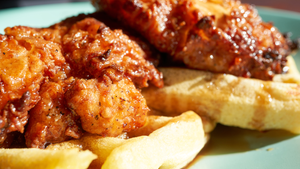FOOD RETAILING CALLED BATTLE ROYAL OF CHANNELS
PALM BEACH, Fla. -- The bottom-line potential in the retail-food industry is so enticing, nearly everyone wants a piece of the market.However, as companies jockey for position in the various channels, they need to balance tried and true methods with enough vision to compete in a complex arena, said John Heinbockel, a securities analyst and vice president at Goldman Sachs, New York.A featured speaker
November 16, 1998
MICHAEL HARRISON
PALM BEACH, Fla. -- The bottom-line potential in the retail-food industry is so enticing, nearly everyone wants a piece of the market.
However, as companies jockey for position in the various channels, they need to balance tried and true methods with enough vision to compete in a complex arena, said John Heinbockel, a securities analyst and vice president at Goldman Sachs, New York.
A featured speaker at the inaugural SN Food Retailing Summit here, his presentation, "The Battle for Share of the Stomach: Maximizing Growth Opportunities and Avoiding Indigestion," was designed "not to give answers but to raise some questions, to see where the battle for market share is headed," Heinbockel said.
According to him, it's a battle royal pitting mainstream grocers against an array of channels that realize "if you want to increase traffic, that's a good way to do it. Food does represent an opportunity to increase margins."
While Heinbockel predicts "the level of competition over the next five years will be quite intense," he preaches moderation.
"There are a lot of opportunities out there. Everyone wants a piece of the action. But I think people should have eyes that match their stomach from the standpoint of format development, people development and product development. There's lots of opportunity in lots of different areas, but it's better to go slowly," he said.
Acknowledging competition is coming "not just from traditional sectors but from growth sectors of the food and drug retail industry -- like the organic-food sector and certainly the Internet," Heinbockel said the successful players will be the ones who employ "a great deal of innovation and a great deal of strategic thought."
The challenges include vying for customers who are "less loyal" and possess "a perception of value that has become quite sophisticated."
With that in mind, he highlighted several top retailers representing some of the various food channels, putting an emphasis on their respective strengths. Starting with Wal-Mart, Bentonville, Ark., Heinbockel said, "Obviously, the supercenters have been a terrific growth vehicle for them and that should continue." Their attributes, he said, include "One-stop shopping and very strong EDLP.
"Now, a lot of traditional food retailers will tell you EDLP does not work for them, it's been a little too boring, not created enough excitement. That's probably because by and large they haven't practiced real pure EDLP, where there is terrific value in the market and they are the undisputed low-price leader."
Wal-Mart's Neighborhood Market format offers "improved physical proximity, strong EDLP" and it's a vehicle that has been able to sustain growth, Heinbockel said. He added that "they have said it's experimental and are not making a big deal about it. But because it is Wal-Mart, we need to take a look at it seriously and see if things can be learned from it."
Others channels he mentioned included:
* Costco Cos., Issaquah, Wash.: Strong everyday low pricing and "a treasure-hunt appeal" that has been able to sustain growth and increase frequency.
* Ahold USA, Atlanta: "Ease of shopping" and "above-average fresh foods."
* 7-Eleven, Dallas: "Above-average convenience" and "improved fresh foods."
* Wild Oats Markets, Boulder, Colo.: "Outstanding perishables and a unique customer blend."
In addition, the newest channel -- the Internet -- offers "the ultimate in convenience and assortment. Obviously, any virtual environment assortment can be unlimited." Simply put, according to Heinbockel, "one of the things the Internet players are trying to do is restructure the logistics of food -- how it can be bought and how it can be delivered."
Now that market share is harder to come by, the onus is on operators to put a maximum effort into keeping core customers while attracting new ones, Heinbockel said. That raises "a whole range of issues," he said, "including promotional strategy, customer service and raising the performance bar."
When it comes to getting the word out, Heinbockel advocates "stealth marketing" via a card program. "It's a terrific advertising tool," he said. "You're not advertising to the world, it's very intelligent, very low-profile and appropriate."
In addition, though he called it "probably the most over-hyped [concept]," Heinbockel said "getting home-meal replacement right" is one of the key areas to concentrate on. However, "before you get there, there are probably some other things you'll want to get right first and that starts with frozens and it goes to pizza, barbecue chicken and a sandwich program."
Also, if a company is looking to take a page from a successful operator's book, it should realize that "the companies that are most successful are the ones who have the most focus, focus on the customer and focus on what you do best." Heinbockel said companies looking to improve have to ask themselves "what are our strengths, what are our weaknesses -- and what we're doing in the field, does that complement what our true strengths are?
"The key is leveraging your core competencies and not trying to be something you're not. It has never been more important to match strategy and strengths," he said.
About the Author
You May Also Like




